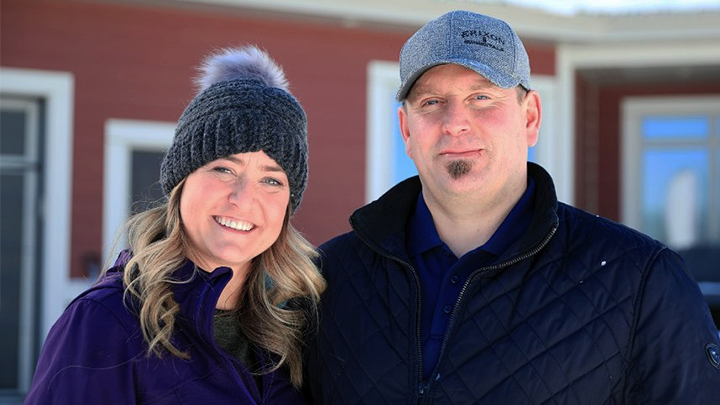
April 25, 2019
Story by Debby Waldman Photo by Ewan Nicholson
BEAUMONT — Growing up on a farm, Lexi Golinsky and her brother, Scott Barr, fought like typical siblings. When they compare scars from their childhood scuffles, they break into laughter.
But when they compare their latest scars, they’re just as likely to break into tears. Those matching scars are from when Barr, 41, donated his kidney to Golinsky, 38, in 2006.
In 2005, Golinsky was diagnosed with IgA nephropathy, a recurring form of kidney disease in which immunoglobulin (IgA) lodges in the kidneys. Doctors at the University of Alberta Hospital told her she would eventually need dialysis or a new kidney.
“People who are in excellent health are more likely to be accepted as living kidney donors,” says Dr. Soroush Shojai, a transplant nephrologist at the University of Alberta Hospital and co-chair of the Living Donor Kidney Transplant Working Group. “Blood relatives are often the closest donor matches, but other transplant recipients have found living donors through their personal and professional networks.”
Golinsky’s doctors said that her kidneys could continue working for five more years, but it didn’t happen that way. After only a year, blood work showed her kidney function was at eight per cent, down from 30 per cent. Her doctors told her to start looking immediately for a living kidney donor.
“I thought I had more time,” she says. She called Barr and asked if he could be her living kidney donor. Barr, who works in the agricultural industry, was busy getting ready for spring seeding, but he didn’t hesitate.
“It’s family,” says Barr. “You just do it. No questions asked.”
From April to June of 2006, Barr underwent a battery of tests, mostly in Saskatoon, to determine whether he was a suitable donor. Medical staff in Saskatoon coordinated with their colleagues at the University of Alberta, where the transplant would take place. An athlete and a farmer, Barr kept himself in good shape and led a healthy lifestyle; he proved to be an ideal candidate.
“We can coordinate tests when potential donors and recipients live in different provinces,” says Dr. Shojai. “We can also plan the surgeries when they are in the best possible physical and emotional health for surgery. This helps everyone make plans for work, travel and family duties.”
While Golinsky waited for confirmation that her brother was a match, she balanced four peritoneal dialysis treatments a day while teaching full time in Vermilion. Because the dialysis made her feel sick, she could no longer curl or golf. She also quit her baseball team.
By the end of June, Barr had been approved as Golinsky’s kidney donor. The medical team was eager to schedule the transplant, but there were other pressing engagements on the siblings’ calendars: Golinsky’s wedding to her fiancé, Brad, was set for August, while Barr’s to his fiancée, Jody, was set for October.
“We told our doctors, ‘We just have these things to get done first,’ and they said, ‘Well, shouldn’t the transplant take priority?’” Golinsky recalls. She assured her doctors that she and Barr would make the transplant happen right after their respective weddings.
Both surgeries took place on Dec. 19, 2006. A few days later, Barr returned to Saskatchewan and Golinsky to Leduc. Both were back home in time to celebrate Christmas with their new spouses.
Over the next five years, Golinsky continued to live an active life and teach. She curled, golfed and rejoined her baseball team.
In 2011, the Golinskys learned they were going to be parents. However, during the pregnancy, Lexi developed pre-eclampsia, which can cause high blood pressure. The condition took a toll on her kidneys and cut her pregnancy short.
The Golinsky's daughter, Quinn, was born at 22 weeks. In her memory, the couple have her tiny handprint tattooed on their wrists.
Golinsky’s doctors said another pregnancy would be physically and psychologically risky. Through a surrogate, however, the Golinskys did become parents to twin boys, Max and Cohen. When the boys were one, Golinksy’s kidney disease came back and, with it, the prospect of returning to dialysis.
Golinsky felt guilty that her brother’s kidney only lasted only 11 years in her body. But Barr didn’t see it that way. “I had the chance to save my sister’s life,” he says. “Would I do it again? Absolutely.”
Family and friends put out the word that Golinsky needed another kidney. The response was both swift and overwhelming. “It only takes one person to ask,” says Barr. “And the donor can be anybody.”
This time, the donor came forward from Golinsky’s professional network. She received the new kidney in January 2018.
“It’s hard to express how grateful I am,” she says. “My brother gave me a kidney, my friend gave me a kidney, and another friend gave us our children. The love that I feel for the people who have helped me is beyond amazing.”
Lexi and Scott agreed to share their story to highlight the importance of National Organ and Tissue Donation Awareness Week (NOTDAW). NOTDAW, which celebrates organ and tissue donation and raises awareness about the critical need for more donors, runs April 21 to 27 this year.

Scott Barr didn’t hesitate when his sister, Lexi, asked him to donate his kidney to her. “It’s family. You just do it. No questions asked.”
Living Donor Services Transplant Services
University of Alberta Hospital in Edmonton
Phone: 780-407-8698
Toll Free: 1-866-253-6833 (Canada only)
Email: LivingDonors@albertahealthservices.ca
Southern Alberta Transplant Program
Living Donor Program in Calgary
Phone: 403-944-4635
Email: ALTRAFMC.Living.Donor@albertahealthservices.ca
For more information on living kidney donation or kidney transplantation, please visit: myhealth.alberta.ca/HealthTopics/kidney-transplant